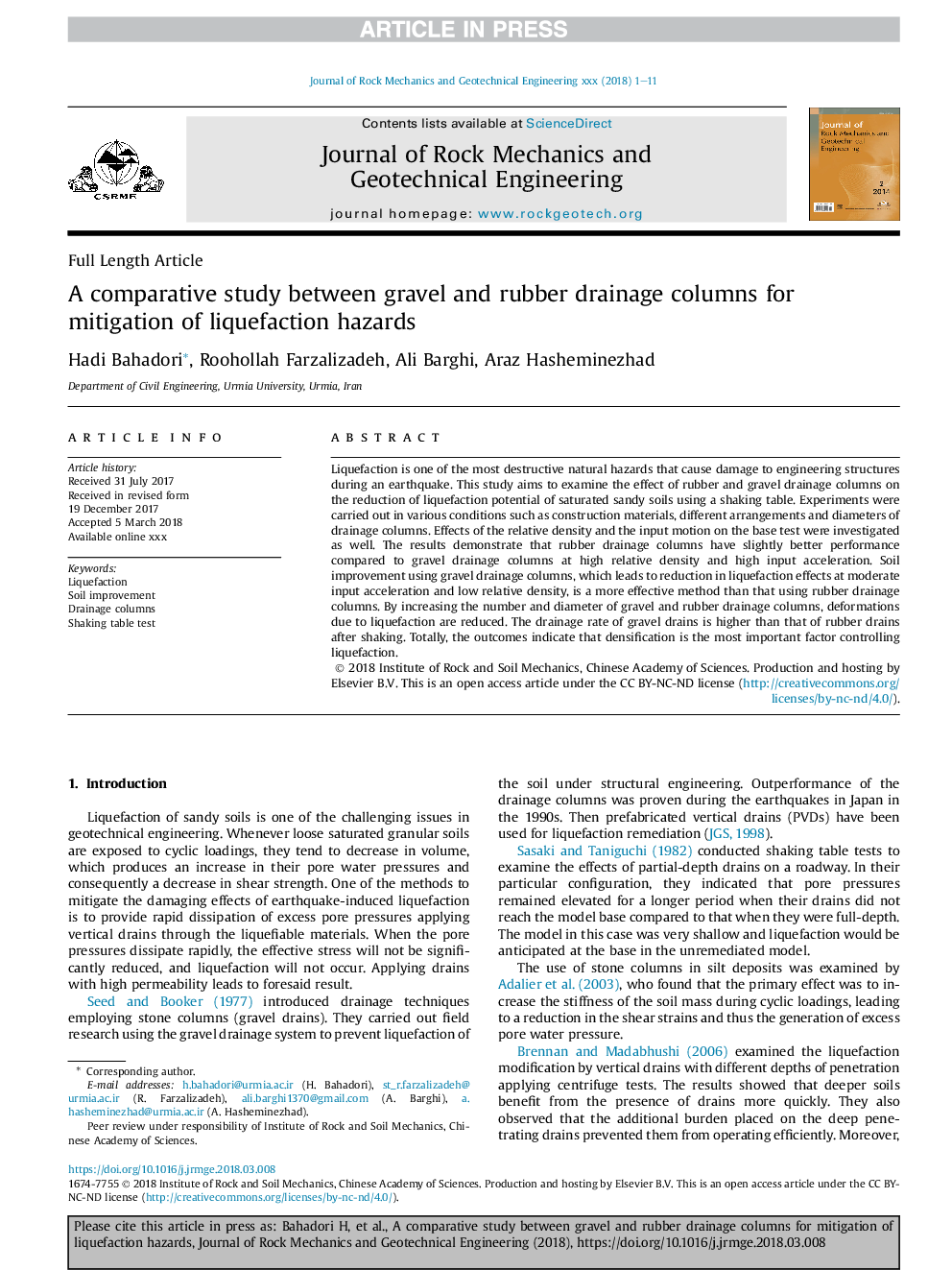| کد مقاله | کد نشریه | سال انتشار | مقاله انگلیسی | نسخه تمام متن |
|---|---|---|---|---|
| 11017530 | 1725873 | 2018 | 11 صفحه PDF | دانلود رایگان |
عنوان انگلیسی مقاله ISI
A comparative study between gravel and rubber drainage columns for mitigation of liquefaction hazards
ترجمه فارسی عنوان
یک مطالعه مقایسه ای بین ستون های زهکشی شن و ماسه برای کاهش خطرات مایع سازی
دانلود مقاله + سفارش ترجمه
دانلود مقاله ISI انگلیسی
رایگان برای ایرانیان
کلمات کلیدی
تبدیل به مایع، بهبود خاک، ستون های زهکشی تست جدول تکان دادن،
ترجمه چکیده
روانابسیون یکی از مخرب ترین خطرات طبیعی است که در طی زلزله باعث ایجاد آسیب به سازه های مهندسی می شود. هدف از این مطالعه بررسی اثر ستون های زهکشی لاستیکی و خاکستری بر کاهش پتانسیل مایع شدن خاک های شنی اشباع با استفاده از جدول تکان دادن است. آزمایش ها در شرایط مختلف از قبیل مواد ساختمانی، ترتیبات مختلف و قطر ستون های زهکشی انجام شد. اثر تراکم نسبی و حرکت ورودی به آزمون پایه نیز مورد بررسی قرار گرفت. نتایج نشان می دهد که ستون های زهکشی لاستیکی عملکرد کمی نسبت به ستون های زهکشی شن در چگالی نسبی بالا و شتاب ورودی بالا دارند. بهبود خاک با استفاده از ستون های زهکشی سنگی که منجر به کاهش اثرات مایع شدن در شتاب ورودی متوسط و چگالی نسبی پایین می شود، روش مؤثرتری نسبت به استفاده از ستون های زهکشی لاستیکی است. با افزایش تعداد و قطر ستون های زهکشی و شن و ماسه، تغییرات ناشی از مایع سازی کاهش می یابد. میزان تخلیه تخلیه شن در مقایسه با تخلیه لاستیک ها پس از تکان دادن بیشتر است. در مجموع، نتایج نشان می دهد که تراکم ترین عامل کنترل مایع سازی است.
موضوعات مرتبط
مهندسی و علوم پایه
علوم زمین و سیارات
مهندسی ژئوتکنیک و زمین شناسی مهندسی
چکیده انگلیسی
Liquefaction is one of the most destructive natural hazards that cause damage to engineering structures during an earthquake. This study aims to examine the effect of rubber and gravel drainage columns on the reduction of liquefaction potential of saturated sandy soils using a shaking table. Experiments were carried out in various conditions such as construction materials, different arrangements and diameters of drainage columns. Effects of the relative density and the input motion on the base test were investigated as well. The results demonstrate that rubber drainage columns have slightly better performance compared to gravel drainage columns at high relative density and high input acceleration. Soil improvement using gravel drainage columns, which leads to reduction in liquefaction effects at moderate input acceleration and low relative density, is a more effective method than that using rubber drainage columns. By increasing the number and diameter of gravel and rubber drainage columns, deformations due to liquefaction are reduced. The drainage rate of gravel drains is higher than that of rubber drains after shaking. Totally, the outcomes indicate that densification is the most important factor controlling liquefaction.
ناشر
Database: Elsevier - ScienceDirect (ساینس دایرکت)
Journal: Journal of Rock Mechanics and Geotechnical Engineering - Volume 10, Issue 5, October 2018, Pages 924-934
Journal: Journal of Rock Mechanics and Geotechnical Engineering - Volume 10, Issue 5, October 2018, Pages 924-934
نویسندگان
Hadi Bahadori, Roohollah Farzalizadeh, Ali Barghi, Araz Hasheminezhad,
